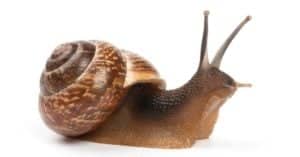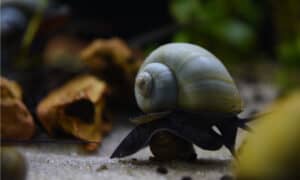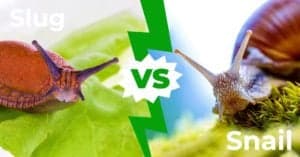The garden snail (Cornu aspersum) is a well-known species of land snail now found on six continents. They are a culinary delight in some regions (escargot in France, and bover in Catalonia), but they are better known as agricultural pests. The garden snail is native to the Mediterranean region, but, with the help of humans, it has spread across the world.
Adult garden snails have shells approximately 1.5 inches in diameter. The shell can be different shades of brown and usually has yellow streaks throughout. Their body is typical of a snail: slimy, soft, and a greyish-brown color. The body can fully retract into the shell. When necessary, the snail will create a membrane of mucus across the shell’s opening to defend against predators or bad weather.
C. aspersum is a member of the Helicidae family, a diverse collection of land snails. The term “garden snail” is used interchangeably for a variety of species and this species is sometimes confused with Helix pomatia. The garden snail is further classified into subspecies based on shell composition, location, and other factors.
The Garden Snail Diet
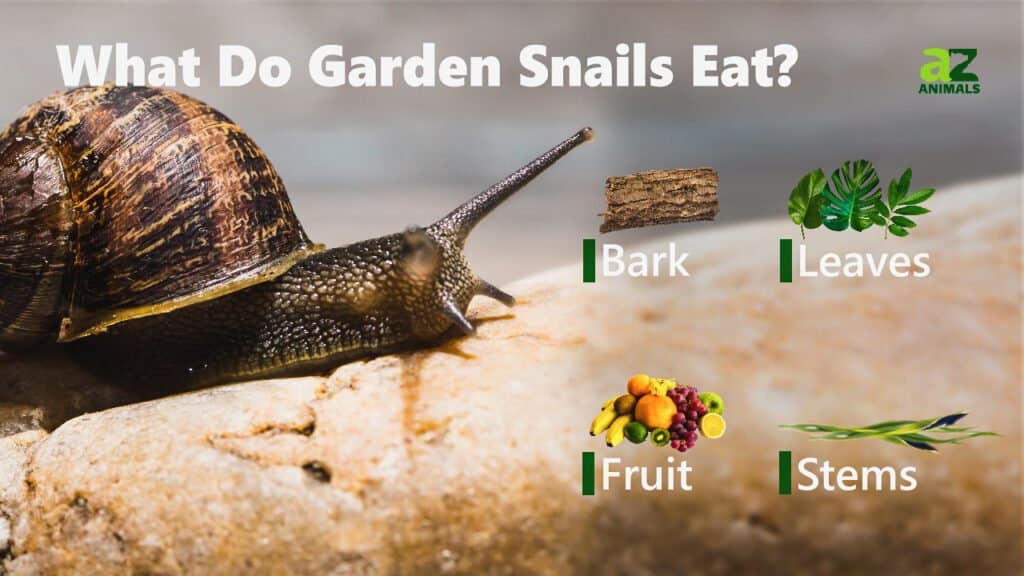
Garden snails eat leaves, vegetables, and flowers, but they occasionally consume dead animal matter like worms and other snails. They are considered omnivorous scavengers. The species enjoys most garden crops and will quickly lay waste to a variety of plants, including:
- Hosta
- Marigolds
- Cabbage
- Beans
- Lettuce and other greens
- Dahlia
- Delphinium
- Tomatoes
- Cucumbers
Snails have the peculiar ability to gather and detoxify heavy metals. They don’t consume the metals—rather, the metals are processed and deposited into the snail’s shell. When researchers want to determine if a region has heavy metals present, they can take snail shell samples to find out.
While not a part of their diet, snails are highly attracted to beer. This fact has been exploited by gardeners around the world. When snails become a pest in the garden, the recommended course of action is to place bowls of beer around the problem areas. The snails head towards the bowls, slide into the liquid, and end up drowning.
The diet of edible snails is usually different than their wild counterparts. Snail farmers usually use ground grains and cereals for feed.
Garden snails do not require drinking water, but their environment needs to remain humid enough to support their slimy body. Humidity needs to stay above 65% or the snails will need to seek shelter or seal themselves in their shell.
What Can Garden Snails Not Eat?
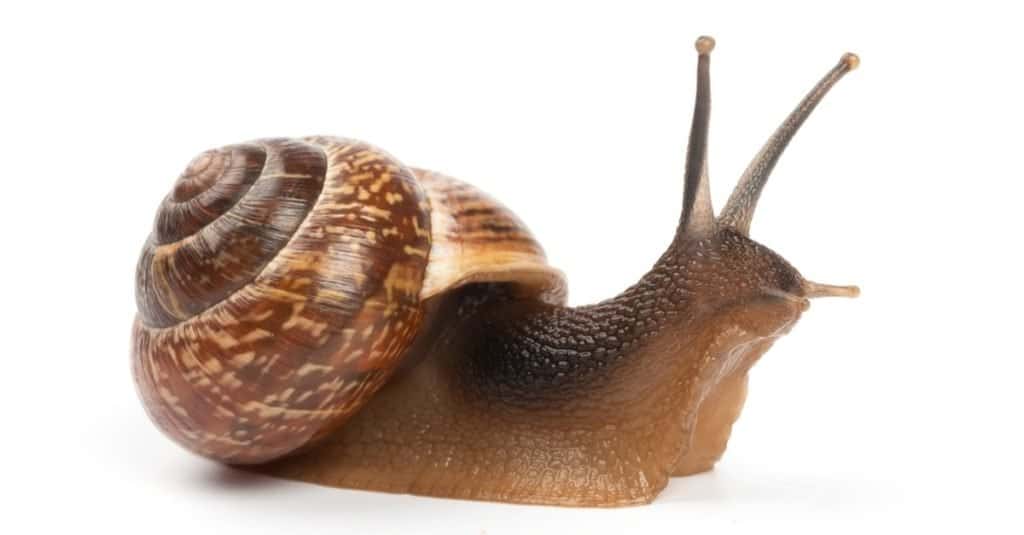
Garden snails eat a large variety of plant materials.
©Stepan Bormotov/Shutterstock.com
Garden snails should not consume processed foods, rice, bread, crackers, or, most importantly, salt. Salt robs the snail of its moisture and can easily kill it in high enough concentrations.
What Animals Eat Garden Snails?
Garden snails have many predators, including birds, lizards, frogs, small mammals, and larger snails. There are even a few insects, such as the glowworm beetle, that commonly hunt and consume snails.
Can Humans Eat Garden Snails?

Common garden snails have a top speed of 45 meters per hour, making the snail one of the
slowest creatures on Eart
h.
©Alexander Raths/Shutterstock.com
Garden snails are edible and considered a delicacy in some regions. Escargot is the most well-known dish, originating in France but now common around the world. The snails are typically removed from the shell, cooked in butter, stock, wine, or spices, and served back in their shells. Other cultures have different preparations.
In addition, research is underway on medical and cosmetic uses for snails. The secretions from the snail contain antioxidants for skin regeneration and are used in many skin products. These gels and creams are said to be effective at combating dry skin, scars, wrinkles, and acne.
Can Snails Bite?
Yes, snails can bite their prey or humans if provoked. Some species have thousands of teeth, but due to their small size, garden snails can’t cause injury to humans. They don’t technically bite, instead licking or rubbing with their mouth and tongue. Other species, such as the cone snail, have a toxic bite, and any snail can spread disease and parasites.
How To Get Rid of Snails in the Garden
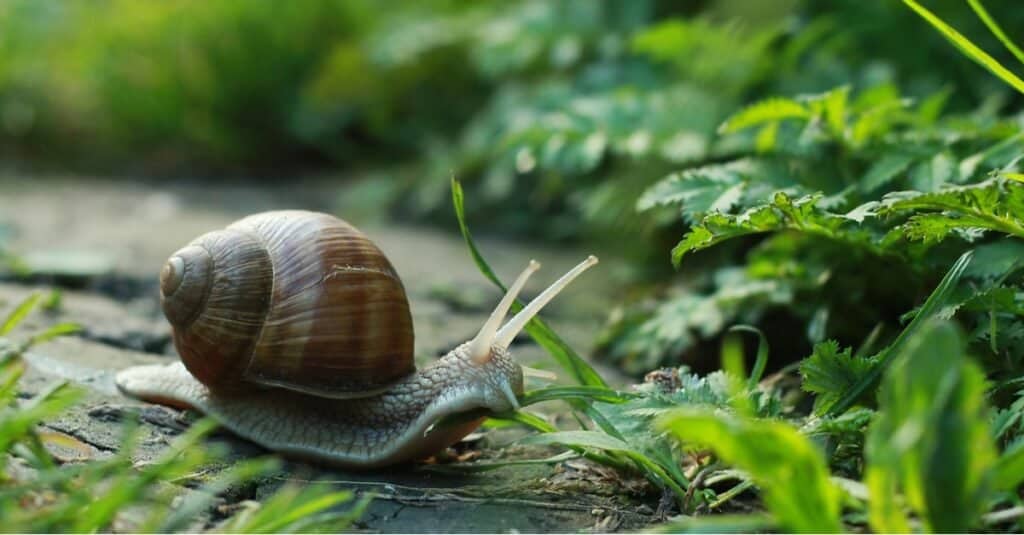
Many gardeners will sprinkle diatomaceous earth around the perimeter of the garden to rid the area of snails.
©Zuzha/Shutterstock.com
Like most garden pests, snails can quickly destroy crops and gardens if not taken care of. In addition to the “beer in a bowl” trap mentioned above, there are a few other ways to get rid of snails in the garden.
Barriers are an effective snail repellent. Many gardeners will sprinkle diatomaceous earth around the perimeter of the garden. When the snail crawls over the barrier, the rough, sharp particles of the diatomaceous earth will rip away at the snail’s skin. This method is effective against many other insect pests as well.
Natural predators can be introduced into the garden to control a snail population. Chicken, ducks, beetles, turkeys, and frogs will all be happy to work as your snail defense system.
Is it Okay to Hold Garden Snails?
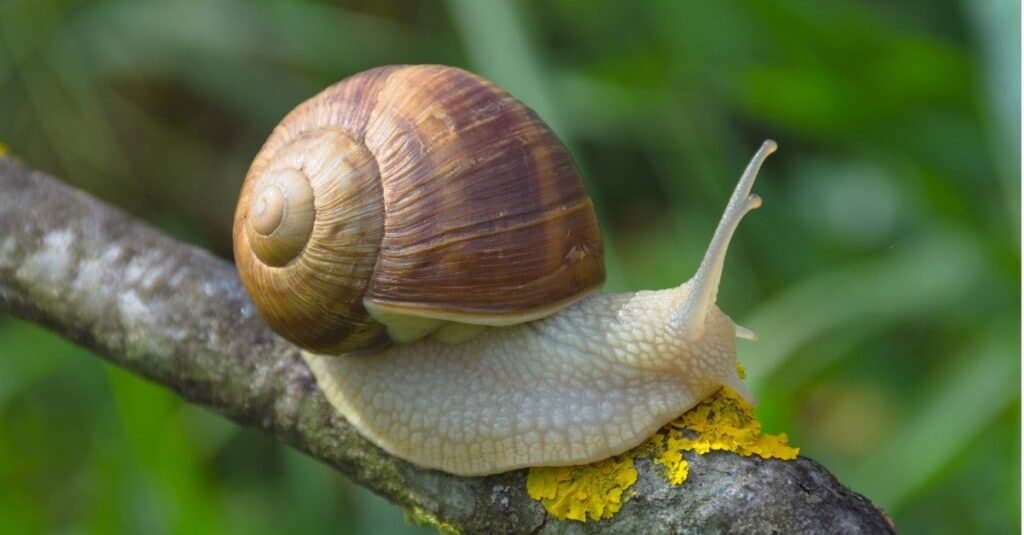
You should refrain from picking up a snail that is clingy tightly to a surface, whether it is a pet snail in a tank or one that is found in your garden, as this could lead to injury and even death.
©Aron M/Shutterstock.com
While handling a garden snail is usually safe, there are a few measures you should take in order to avoid causing them harm. There are certain things that they shouldn’t come in contact with and you should always wash your hands with soap and water before touching them. This will remove any oils or lotions that you may have on your skin that may be absorbed by these land snails.
You should also refrain from picking up a snail that is clingy tightly to a surface, whether it is a pet snail in a tank or one that is found in your garden. Forcibly removing them from where they are can lead to serious injury, like mantle collapse where their muscles get damaged, which will lead to suffocation and starvation. To avoid damaging their muscle, you should never pick them up by their shells.
Make sure when you pick them up, you do so with slightly wet hands as well as scooping them up in a way that breaks their suction, like from underneath their feet.
The photo featured at the top of this post is © iStock.com/Daniela Schröder
FAQs (Frequently Asked Questions)
Are Garden Snails Hermaphrodites?
Garden snails are hermaphrodites and possess both male and female gametes. While sexual reproduction is most common, self-fertilization is also possible. Like many other snails and slugs, the garden snail uses love darts to pick out potential partners. They lay dozens of pearly-white eggs up to 6 times per year, hiding them under rocks or soil.
What is the Difference Between Snails and Slugs?
The primary difference between a snail and slug is the shell: snails have shells and slugs do not. Snails tend to move faster than slugs. Each creature has a single “foot” upon which they glide, creating a slimy mucus to help them glide along.
Slugs have an easier time squeezing into shelter, but snails can hide away in their shell whenever required. They are both part of the Gastropoda class of animals that includes sea snails, freshwater snails, land snails, slugs, and limpets.
Thank you for reading! Have some feedback for us? Contact the AZ Animals editorial team.



